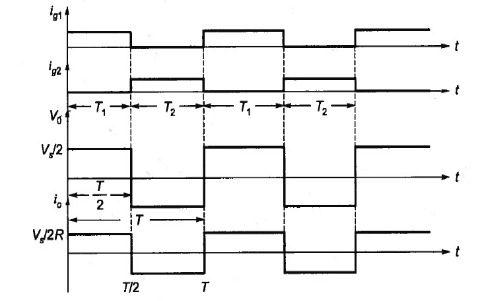The inverter is a power electronic converter that converts direct power to alternating power. By using this inverter device, we can convert fixed dc into variable ac power which as a variable frequency and voltage.
Secondly from this inverter, we can vary the frequency i.e we will be able to generate the 40HZ, 50HZ, 60HZ frequencies as of our requirement.
Half-Bridge Inverter:-
The inverter is a device that converts a dc voltage into ac voltage and it consists of four switches whereas half-bridge inverter requires two diodes and two switches which are connected in anti-parallel. The two switches are complementary switches which means when the first switch is ON the second switch will be OFF Similarly, when the second switch is ON the first switch will be OFF.
Single Phase Half Bridge Inverter with Resistive Load
The circuit diagram of a single-phase half-bridge inverter with resistive load is shown in the below figure.
Where RL is the resistive load, Vs/2 is the voltage source, S1 and S2 are the two switches, i0 is the current. Where each switch is connected to diodes D1 and D2 parallelly. In the above figure, the switches S1 and S2 are the self-commutating switches. The switch S1 will conduct when the voltage is positive and current is negative, switch S2 will conduct when the voltage is negative, and the current is negative. The diode D1 will conduct when the voltage is positive and current is negative, diode D2 will conduct when the voltage is negative, and the current is positive.
Case 1 (when switch S1 is ON and S2 is OFF): When switch S1 is ON from a time period of 0 to T/2, the diode D1 and D2 are in reverse bias condition and S2 switch is OFF.
Applying KVL (Kirchhoff’s Voltage Law)
Vs/2-V0=0
Where output voltage V0= Vs/2
Where output current i0 = V0/R= Vs/2R
In case of supply current or switch current, the current iS1 = i0 = Vs/2R, iS2 = 0 and the diode current iD1 = iD2 = 0.
Case 2 (when switch S2 is ON and S1 is OFF): When switch S2 is ON from a time period of T/2 to T, the diode D1 and D2 are in reverse bias condition and S1 switch is OFF.
Applying KVL (Kirchhoff’s Voltage Law)
Vs/2+V0=0
Where output voltage V0= -Vs/2
Where output current i0 = V0/R= -Vs/2R
In case of supply current or switch current, the current iS1 = 0, iS2 = i0 = -Vs/2R and the diode current iD1 = iD2 = 0.
The single-phase half-bridge inverter output voltage waveform is shown in the below figure.

The average value of output voltage is





कोई टिप्पणी नहीं:
एक टिप्पणी भेजें